21.5-inch iMac (Late 2013) Review: Iris Pro Driving an Accurate Display
by Anand Lal Shimpi on October 7, 2013 3:28 AM ESTThe Display
When it was first announced, I shrugged off the 21.5-inch iMac model. At the time I was using a 27-inch Thunderbolt Display and couldn’t see myself using anything smaller, or lower resolution. With the new 27-inch iMac looking a lot like last year’s model with evolutionary upgrades on the internals, I was obviously drawn to the new 21.5-inch system because of its use of Intel’s Iris Pro 5200 graphics so I ended up with the first < 3MP desktop display I’d used since the release of the first 30-inch 2560 x 1600 panels years ago.
Given how much time I spend on notebook displays these days, now was as good a time as any to go back to a 1080p desktop display. While I’d prefer something with an insanely higher resolution, it’s still too early for a 21.5-inch 4K panel (or a 27-inch 5K panel), which Apple would likely move to in order to bring Retina displays to its desktops.
There are two reasons why you’d opt for the 21.5-inch iMac vs. the larger one: cost and size. At a bare minimum you’re looking at a $500 price difference between the 21.5 and 27-inch iMacs, which is pretty substantial to begin with. The size argument is just as easy to understand. The 27-inch iMac occupies a considerable amount of space on my desk, and I’ve come to realize that not everyone likes to be surrounded by a sea of desks. Either way there’s clearly a market for a computer this size, with this sort of a resolution. So how does the display fare?
In short: it’s nearly perfect.
Brian and I were comparing notes on the two reviews we’re working on at the same time. He sent me some CIE diagrams showing me color accuracy for the displays he’s testing, I responded with this:

21.5-inch iMac (Late 2013) Saturations
Those boxes show what’s expected, the circles inside of them show what’s delivered by the display. The 21.5-inch iMac is spot on, out of the box, without any calibration required. Brian’s response:
WOW
is that out of the box?
The iMac’s display does extremely well in all of our tests, always turning in a delta E of less than 2. It’s just incredible. I'm borrowing the graphs below from our tablet bench data, but I've tossed in the 2013 MacBook Air as a reference point.

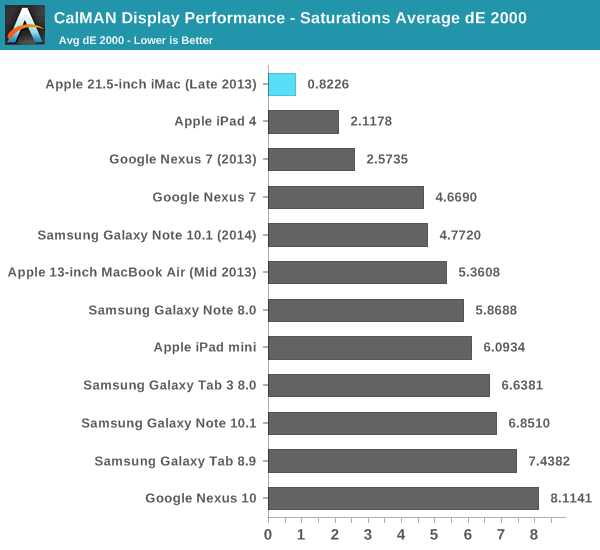
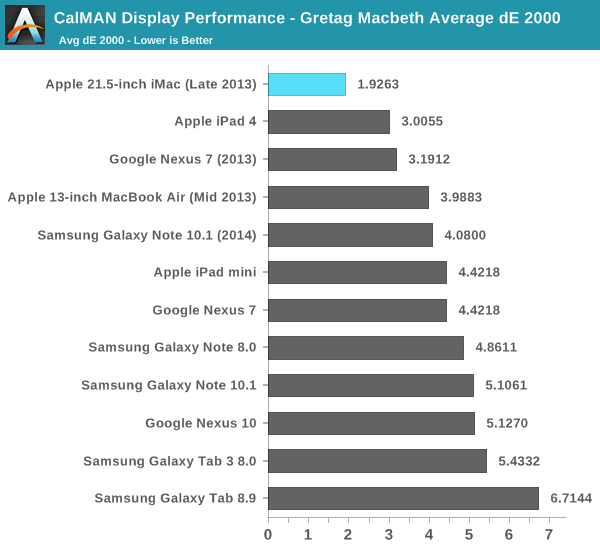

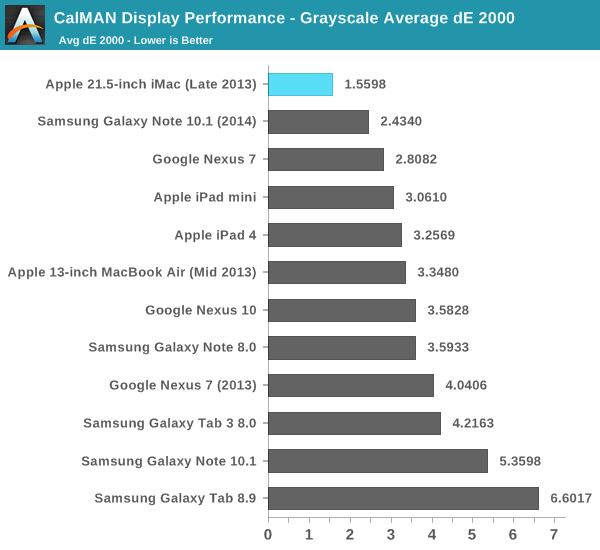
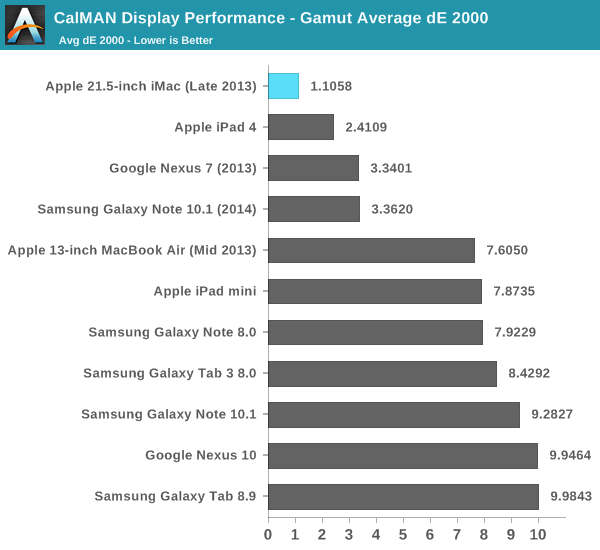

Although I doubt Apple’s intended audience for the entry-level 21.5-inch iMac are imaging professionals, they could very well use the system and be perfectly happy with it. Literally all that’s missing is a 2x resolution model, but my guess is it’ll be another year before we see that.
I have to point out that Apple does source its display panels from multiple providers (typically 2 or 3), not to mention panel variance within a lot. I don’t anticipate finding many panels better than the one in my review sample, but it’s always possible that there will be worse examples in the market. I haven’t seen huge variance in color accuracy from Apple panels, so I think it’s a pretty safe bet that what you’re going to get with any new iMac is going to be awesome.



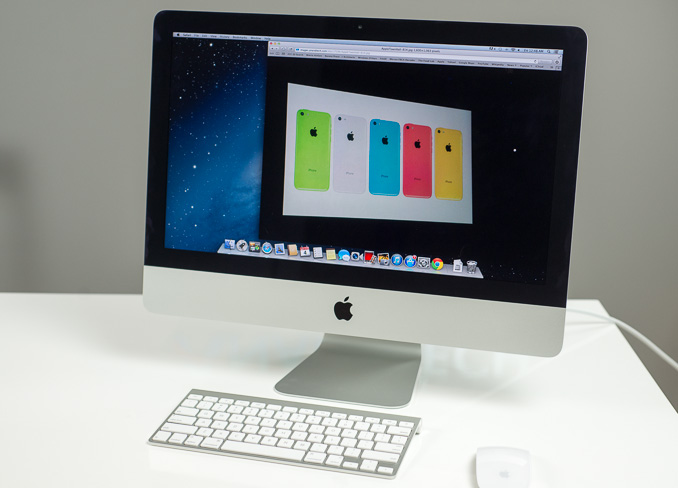











127 Comments
View All Comments
Res1233 - Wednesday, October 30, 2013 - link
Mac OS X is the main reason I buy macs. I have a feeling that you are right about most mac users having no clue what they're buying, but I could go on for hours about the advantages of OS X (geek-wise). No, hackintoshes are not an option if you want any kind of reliability, so don't even go there. If you force me to, I will explain my reasoning in depth to practically anandtech-levels, but I'm not in the mood right now. Perhaps another time! :)tipoo - Monday, October 7, 2013 - link
What are the chances of the 13" Pro duo getting Iris Pro 5200? I'd really love that.Bob Todd - Monday, October 7, 2013 - link
Have they announced any dual core Iris Pro parts? I know the original SKU list just had them in the quads. I still assume the 13" rMBP will get the 28W HD 5100 (hopefully in base configuration, but there will probably be a lower spec i5 below that).Flunk - Monday, October 7, 2013 - link
It's unsure, a new part could be announced at any time. Intel has even made variants specifically for Apple before.tipoo - Monday, October 7, 2013 - link
It shouldn't have to be dual core to be in the 13" pros though. Intel has quads in the same TDP as the current duals in it. A quad core, with GT3e, that would make it an extremely tempting package for me.Sm0kes - Tuesday, October 8, 2013 - link
I think anything but GT3e in the 13'' Macbook Pro is going to be a disappointment at this point. How their 13'' "pro" machine has gone this long with sub-par integrated graphics is mind boggling. The move to a retina display really emphasized the weakness.I'd also venture a guess that cost is the real barrier, as opposed to TDP.
tipoo - Thursday, October 10, 2013 - link
Perhaps. Yeah, the 13" has been disappointing to me, I love the form factor, but hate the standard screen resolution, and the HD4000 is really stretched on the Retina. If it stays a dual core, I don't see a whole lot of appeal over the Macbook Air 13" either. To earn that pro name, it really should be a quad with higher end integrated graphics.Hrel - Monday, October 7, 2013 - link
"This is really no fault of Apple’s, but rather a frustrating side effect of Intel’s SKU segmentation strategy."So I take it I'm not the only one infuriated by the fact that Intel hasn't made Hyperthreading standard on all of it's CPU's.
I remember reading, on this site, that HT adds some insignificant amount of die area, like 5% or something, but is capable of adding up to 50% performance. (in theory). If that's the case the ONLY reason to not include it on EVERY CPU is to nickel and dime your customers. Except it should really be "$100" your customers since only the i7's have HT.
Isn't the physical capability of HT already on ALL cpu's? It just needs to be turned on in firmware right?
DanNeely - Monday, October 7, 2013 - link
With the exception of IIRC dual vs quad core dies and GT2 vs GT3 graphics almost everything that differs between CPUs in a generation is either binning or disabling components if too few dies with a segment non-functional are available for the lower bin.Intel could differentiate its product line without doing any segment disabling on the dies; but it would require several times as many different die designs which would require higher prices due to having to do several times as much validation. Instead we get features en/disabled with fuses or microcode because the cost of the 'wasted' die area is cheaper than the costs associated with validating additional die configurations.
Flunk - Monday, October 7, 2013 - link
Actually the GT2 is just a die-harvested GT3. Intel only have 2 and 4 core versions and crystalwell is an add-on die so there are essentially only 2 base dies, at least for consumers.I do agree about the hyper-threading, there is really no need to disable it. It's not like it really matters in consumer applications anyway.